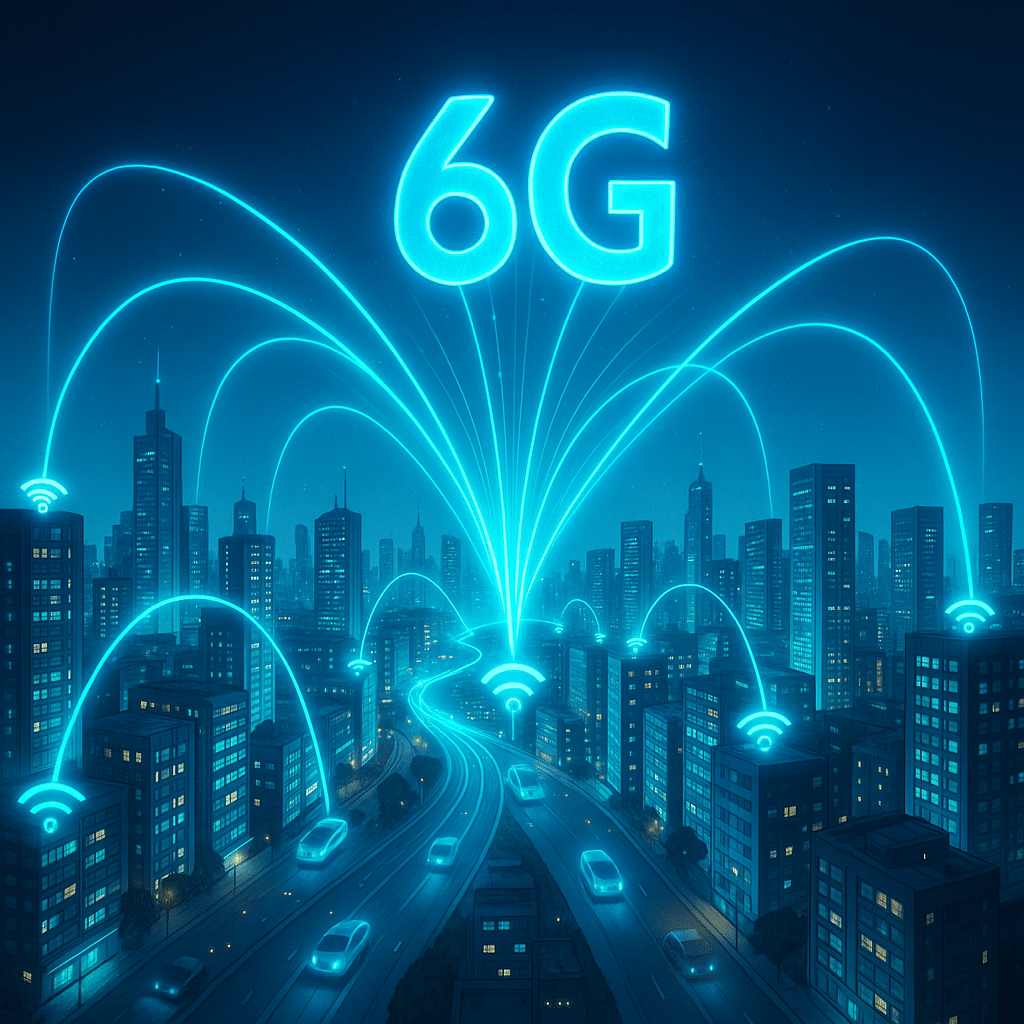6G Technology 2025 & Networks: The Next Leap in Connectivity
Introduction (Beyond 5G – A New Horizon)
By 2025, the tech world is setting its sights on 6G technology – a leap aiming to be 100× faster than 5G. While 5G networks are still expanding globally, research on 6G is already well underway. Early studies suggest 6G could reach 1 terabit per second (Tbps) speeds and sub-millisecond latency, powering applications like immersive holographic communication and pervasive IoT. Countries and companies are racing for leadership, even though rollout isn’t expected until around 2030.
This article explores what 6G entails, how it builds on 5G’s foundation, the innovations it could unlock, and the global state of 6G in 2025.
What Is 6G and Why Does It Matter?
6G is the sixth generation of mobile networks, expected to launch around 2030. Each generation brings a new leap:
- 4G gave us mobile internet and streaming.
- 5G powers IoT and low-latency services.
- 6G promises up to 1 Tbps speeds and ~0.1 ms latency.
This could enable:
- Holographic Communication – lifelike 3D calls in real time.
- Massive IoT – sensors embedded in every building and street.
- Human-Centric Networks – AI-driven, adaptive, secure, and privacy-focused.
- XR Everywhere – augmented and virtual reality without lag.
In short: 6G matters because it is the connective fabric for technologies like autonomous vehicles, advanced robotics, immersive media, and even brain–computer interfaces.
6G vs 5G: Key Features and Improvements
Key differences include:
- Speeds: 5G → up to 10 Gbps; 6G → up to 1 Tbps.
- Latency: 5G → ~1 ms; 6G → <0.1 ms.
- Frequencies: 5G → below 40 GHz; 6G → 100 GHz–1 THz (sub-terahertz/terahertz range).
- AI-native Networking: 6G will integrate AI into network design and operation.
- Network Sensing: 6G signals could also act as radar, monitoring traffic or even health.
- Security: Quantum-resistant encryption, stronger authentication, and built-in privacy.
- Sustainability: Aiming for energy efficiency despite massive performance gains.
Potential Applications of 6G Technology
- Extended Reality (XR) & Holograms – seamless AR/VR with real-time holographic meetings.
- Smart Cities – ultra-dense IoT for instant traffic, utility, and emergency response.
- Autonomous Transport – cars and drones sharing data instantly for safety.
- Telemedicine & Remote Operations – haptic, real-time remote surgeries and industrial robotics.
- Entertainment – instant downloads, interactive streaming, haptic/olfactory media.
- Global Connectivity – seamless integration of satellite + terrestrial networks.
Global Progress: Who Is Leading the 6G Race?
- China: 6G test satellites since 2020, Huawei & ZTE leading, largest patent share.
- USA: Next G Alliance, DARPA research, Qualcomm/Apple/Google active, FCC spectrum studies.
- Europe: Nokia & Ericsson leading EU Hexa-X projects, joint efforts with Japan.
- Japan & South Korea: Ambitious trials by 2026, commercial by 2028–2030, strong Samsung/NTT research.
- Others: India’s “Bharat 6G Vision,” Canada’s antenna materials research.
The race is both geopolitical and collaborative, with standardization expected around 2028 (IMT-2030).
Challenges on the Road to 6G
- Spectrum Limits: Terahertz waves travel only short distances, blocked by walls or rain.
- Hardware: Requires new chipsets, antennas, materials like graphene/photonic tech.
- Energy Efficiency: Prevent overheating and battery drain in terabit transmissions.
- Cost: Dense small-cell infrastructure and new hardware raise ROI concerns.
- Security & Privacy: Sensing data raises surveillance issues; must use quantum-safe encryption.
Mini-FAQ: 6G Networks 2025
Q1: Is 6G available in 2025?
No. 6G is still in labs and research projects. First rollouts expected around 2030.
Q2: How fast will 6G be?
Up to 100× faster than 5G, potentially 1 Tbps in ideal conditions.
Q3: What frequencies will 6G use?
Likely 100–1000 GHz (THz range) plus mid-bands (7–20 GHz) for wider coverage.
Q4: Will 6G need more towers?
Yes, ultra-dense small cells plus intelligent reflectors and hybrid satellite/terrestrial coverage.
Q5: How is 6G tested today?
Via lab prototypes, AI simulations, and testbeds experimenting with terahertz links and massive MIMO.
Conclusion
6G technology 2025 represents both excitement and uncertainty. It promises ultra-fast, intelligent, immersive connectivity but faces steep engineering, cost, and policy challenges.
As of 2025, 6G is shaping roadmaps, patents, and standards – not consumer products. The real test will come in the late 2020s as research converges into deployable networks.
If successful, 6G could enable holographic communication, global AI-driven IoT, smart cities, and seamless integration of digital + physical worlds. It’s less about replacing 5G and more about extending it into a new era of human–machine connectivity.
Further Reading
- Forbes: 6G Is Coming – What Will Be The Business Impact?
- IEEE Spectrum: 6G Is Years Away, but the Power Struggles Have Already Begun
- TechRadar: 6G – Everything You Need to Know About the Next Wireless Standard
- NTT Docomo White Paper on 6G
